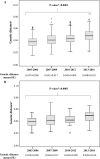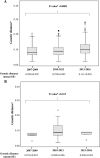Genetic divergence of HIV-1 B subtype in Italy over the years 2003-2016 and impact on CTL escape prevalence
- PMID: 30356083
- PMCID: PMC6200748
- DOI: 10.1038/s41598-018-34058-7
Genetic divergence of HIV-1 B subtype in Italy over the years 2003-2016 and impact on CTL escape prevalence
Abstract
HIV-1 is characterized by high genetic variability, with implications for spread, and immune-escape selection. Here, the genetic modification of HIV-1 B subtype over time was evaluated on 3,328 pol and 1,152 V3 sequences belonging to B subtype and collected from individuals diagnosed in Italy between 2003 and 2016. Sequences were analyzed for genetic-distance from consensus-B (Tajima-Nei), non-synonymous and synonymous rates (dN and dS), CTL escapes, and intra-host evolution over four time-spans (2003-2006, 2007-2009, 2010-2012, 2013-2016). Genetic-distance increased over time for both pol and V3 sequences (P < 0.0001 and 0.0003). Similar results were obtained for dN and dS. Entropy-value significantly increased at 16 pol and two V3 amino acid positions. Seven of them were CTL escape positions (protease: 71; reverse-transcriptase: 35, 162, 177, 202, 207, 211). Sequences with ≥3 CTL escapes increased from 36.1% in 2003-2006 to 54.0% in 2013-2016 (P < 0.0001), and showed better intra-host adaptation than those containing ≤2 CTL escapes (intra-host evolution: 3.0 × 10-3 [2.9 × 10-3-3.1 × 10-3] vs. 4.3 × 10-3 [4.0 × 10-3-5.0 × 10-3], P[LRT] < 0.0001[21.09]). These data provide evidence of still ongoing modifications, involving CTL escape mutations, in circulating HIV-1 B subtype in Italy. These modifications might affect the process of HIV-1 adaptation to the host, as suggested by the slow intra-host evolution characterizing viruses with a high number of CTL escapes.
Conflict of interest statement
The authors have no financial and non-financial competing interests that might be perceived to influence the results and/or discussion reported in this paper. However, Francesca Ceccherini-Silberstein reports personal fees from Gilead Sciences, Bristol-Myers Squibb, Abbvie, Roche Diagnostics, Janssen-Cilag, Abbott Molecular, ViiV Healthcare; grants and personal fees from Merck Sharp & Dohme; grants from Italian Ministry of Education, University and Research (MIUR). Carlo Federico Perno reports grants from Italian Ministry of Instruction, University and Research (MIUR), and from Aviralia Foundation; personal fees from Gilead Sciences, Abbvie, Roche Diagnostics, Janssen-Cilag, Abbott Molecular; and grants and personal fees from Bristol-Myers Squibb, Merck Sharp & Dohme, and ViiV Healthcare. All other authors have nothing to declare.
Figures



Similar articles
-
Fitness-Balanced Escape Determines Resolution of Dynamic Founder Virus Escape Processes in HIV-1 Infection.J Virol. 2015 Oct;89(20):10303-18. doi: 10.1128/JVI.01876-15. Epub 2015 Jul 29. J Virol. 2015. PMID: 26223634 Free PMC article.
-
The degree of HIV-1 amino acid variability is strictly related to different disease progression rates.Virus Genes. 2018 Aug;54(4):493-501. doi: 10.1007/s11262-018-1571-2. Epub 2018 May 17. Virus Genes. 2018. PMID: 29777446
-
Next-generation sequencing analyses of the emergence and maintenance of mutations in CTL epitopes in HIV controllers with differential viremia control.Retrovirology. 2018 Sep 10;15(1):62. doi: 10.1186/s12977-018-0444-z. Retrovirology. 2018. PMID: 30201008 Free PMC article.
-
HIV evolution in response to HLA-restricted CTL selection pressures: a population-based perspective.Microbes Infect. 2008 Apr;10(5):455-61. doi: 10.1016/j.micinf.2008.01.013. Epub 2008 Feb 1. Microbes Infect. 2008. PMID: 18407775 Review.
-
HIV-1 adaptation to HLA: a window into virus-host immune interactions.Trends Microbiol. 2015 Apr;23(4):212-24. doi: 10.1016/j.tim.2014.12.008. Epub 2015 Jan 19. Trends Microbiol. 2015. PMID: 25613992 Review.
Cited by
-
Adaptation to HLA-associated immune pressure over the course of HIV infection and in circulating HIV-1 strains.PLoS Pathog. 2022 Dec 16;18(12):e1010965. doi: 10.1371/journal.ppat.1010965. eCollection 2022 Dec. PLoS Pathog. 2022. PMID: 36525463 Free PMC article.
-
On the Evolutionary Trajectory of SARS-CoV-2: Host Immunity as a Driver of Adaptation in RNA Viruses.Viruses. 2022 Dec 26;15(1):70. doi: 10.3390/v15010070. Viruses. 2022. PMID: 36680110 Free PMC article. Review.

